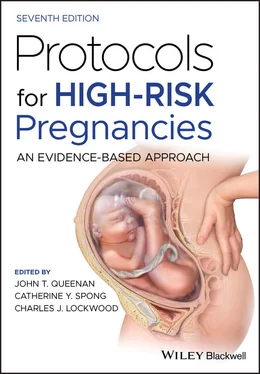John SinnottDepartment of Internal Medicine, Morsani College of Medicine, University of South Florida, Tampa, FL, USA
Bradley SipeDepartment of Obstetrics and Gynecology, Morsani College of Medicine, University of South Florida, Tampa, FL, USA
Catherine Y. SpongDepartment of Obstetrics and Gynecology, Division of Maternal‐Fetal Medicine, University of Texas Southwestern Medical Center, Dallas, TX, USA
Irene A. StaffordDepartment of Obstetrics and Gynecology, Baylor College of Medicine, Houston, TX, USA
Sarah J.E. StockDepartment of Maternal and Fetal Medicine, Usher Institute, University of Edinburgh, Edinburgh, Scotland, UK
Mishka TerplanFriends Research Institute, Adjunct Faculty, Clinical Consultation Center, University of California, San Francisco, CA, USA
Stephen F. ThungDepartment of Obstetrics and Gynecology, The Ohio State University College of Medicine, Columbus, OH, USA
Emilie L. Vander HaarNew York Presbyterian–Weill Cornell Medicine, New York, USA
Vic VelanovichDepartment of Surgery, Morsani College of Medicine, University of South Florida, Tampa, FL, USA
Blair J. WylieDepartment of Obstetrics and Gynecology, Division of Maternal‐Fetal Medicine, Beth Israel Deaconess Medical Center, Harvard Medical School, Boston, MA, USA
Kimberly YonkersDepartments of Psychiatry, Obstetrics, Gynecology and Reproductive Sciences and School of Public Health, Yale University School of Medicine, New Haven, CT, USA
Carolyn M. ZelopDepartment of Obstetrics and Gynecology, NYU School of Medicine, New York, USA
Amanda C. ZofkieDepartment of Obstetrics and Gynecology, Division of Maternal‐Fetal Medicine, University of Texas Southwestern Medical Center, Dallas, TX, USA
Blake ZwerlingDivision of Obstetrics and Gynecology, Irvine School of Medicine, University of California, Irvine, CA, USA
PART 1 Concerns in Pregnancy
PROTOCOL 1 Alcohol Use in Pregnancy and Lactation
Ruta M. Nonacs
Department of Psychiatry, Massachusetts General Hospital, Boston, MA, USA
According to data collected in the 2015–2017 Behavioral Risk Factor Surveillance System conducted by the Centers for Disease Control and Prevention (CDC), 11.5% of pregnant women in the United States reported consuming at least one alcoholic drink during the past 30 days, and 3.9% reported binge drinking (five or more drinks during one episode). Among pregnant women who reported binge drinking, the average frequency of binge drinking was 4.5 episodes during the past 30 days. The highest prevalence of alcohol use during pregnancy was observed in older (ages 35–44 years), college educated, and unmarried women.
According to the same surveillance, the prevalence of any alcohol use was 53.6% among nonpregnant reproductive age women, indicating that pregnancy may be a time of increased motivation to decrease or stop drinking. Even among women with heavy alcohol use or patterns of use consistent with alcohol use disorder, 70–90% abstain from alcohol during pregnancy. Although many women achieve abstinence during pregnancy, studies have noted high rates of relapse during the postpartum period.
Alcohol use during pregnancy
Alcohol use during pregnancy has been associated with an increased risk of fetal death in some, but not all, studies. For example, an increased risk of miscarriage was reported in women who consumed more than three drinks per week (adjusted odds ratio 2.3; 95% confidence interval [CI] 1.1–4.5), compared to women who reported no alcohol consumption. In a Danish study of nearly 90 000 pregnant women, a higher risk of fetal death after 22 weeks’ gestation (adjusted hazard ratio 2.20; 95% CI 1.73–2.80) was observed in pregnant women who reported either three or more drinks per week or two or more binge‐drinking episodes, compared to women who did not drink.
Alcohol exposure during pregnancy also increases the risk of low birthweight and extreme preterm birth (<32 weeks’ gestation), factors which may contribute to higher rates of neonatal morbidity and mortality and may have long‐term neurodevelopmental consequences.
Most studies have focused on the negative effects of alcohol on fetal development. Alcohol is a known teratogen and exposure early in pregnancy, during the period of organogenesis, has been associated with growth restriction and a constellation of physical abnormalities, including dysmorphic facial features, microcephaly, cardiac defects, and eye and ear abnormalities. Exposure to alcohol at any point during the pregnancy can compromise development of the fetal brain. Prenatal alcohol exposure is one of the leading causes of mental retardation and may result in long‐term deficits in cognitive, behavioral, and emotional functioning.
Fetal alcohol spectrum disorders (FASD) encompass several diagnostic subtypes. Children with fetal alcohol syndrome (FAS) are the most severely affected and present with characteristic facial features (e.g., thin upper lip, small, wide‐set eyes, upturned nose), microcephaly, small stature, and cognitive deficits, including developmental delays and lower IQ, as well as emotional and behavioral problems. Children with alcohol‐related neurodevelopmental disorder (ARND) lack the characteristic facial defects and growth retardation seen in children with FAS but have alcohol‐induced mental impairment.
The effects of alcohol exposure on the developing fetus are variable. While any amount of alcohol consumption may have adverse effects, binge drinking is especially concerning as it has been associated with higher risk of FASD. Children born to women of lower socioeconomic status appear to be more susceptible to the effects of alcohol in utero, a finding which suggests that other factors, including nutritional status and environmental exposures, may contribute to the pathophysiology of FASD. Currently, there is no known amount of alcohol consumption during pregnancy which is considered to be safe.
Prevalence estimates of FAS have varied widely from 0.5 to 3 per 1000 live births; however, studies using in‐person assessments of school‐aged children report higher estimates of FAS: 6–9 per 1000 children. Few estimates for the full range of FASDs are available; the most current estimate of the prevalence of FASD among US children is approximately 1%.
Alcohol use during lactation
Approximately half of all breastfeeding women in the US report consuming alcohol; however, relatively little is known about the consequences of alcohol intake in breastfeeding women and their infants. Alcohol consumed by the mother passes into the breast milk, with levels peaking 30–60 minutes after an alcoholic beverage is consumed. While the alcohol from one drink can be detected in breast milk for about 2–3 hours, alcohol is detectable in the breast milk for about 4–5 hours if the mother consumes two drinks and for about 6–8 hours if she consumes three drinks, and so forth. Other factors influencing the amount of alcohol in breast milk include how fast it is consumed, whether it is consumed with food, the mother’s body mass index (BMI), and how quickly she metabolizes alcohol.
It has been demonstrated that alcohol inhibits the release of oxytocin, the hormone which stimulates milk ejection, an effect which decreases the amount of milk available to the nursing infant. Higher amounts of alcohol intake appear to have a greater effect; however, one study noted that drinking as little as 0.3 g alcohol per kg (a little more than a 12‐ounce beer or mixed drink) may reduce milk production by about 10%. Other studies have observed that the infants of mothers who consume alcohol tend to take in less breast milk per feeding and may also have disrupted sleep patterns.
Читать дальше












